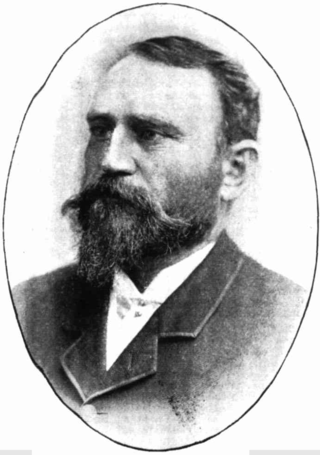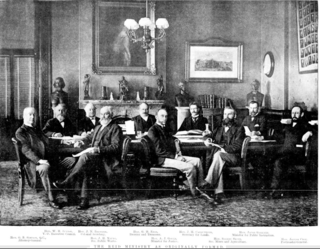East Sydney was an electoral district for the Legislative Assembly, in the Australian colony of New South Wales created in 1859 from part of the Electoral district of Sydney City, covering the eastern part of the current Sydney central business district, Woolloomooloo, Potts Point, Elizabeth Bay and Darlinghurst, bordered by George Street to the east, Boundary Street to the west, and, from the creation of South Sydney in 1880, Liverpool Street and Oxford Street, to the south. It elected four members simultaneously, with voters casting four votes and the first four candidates being elected. For the 1894 election, it was replaced by the single-member electorates of Sydney-King, Sydney-Fitzroy and Sydney-Bligh.
Namoi, known as The Namoi until 1910 was an electoral district of the Legislative Assembly in the Australian state of New South Wales, created in 1880 and named after the Namoi River. It elected two members between 1891 and 1894. In 1894 it was abolished and partly replaced by Narrabri. In 1904, with the downsizing of the Legislative Assembly after Federation, Namoi was recreated, replacing Narrabri and part of Gunnedah. Between 1920 and 1927, it largely absorbed Gwydir and Tamworth and elected three members under proportional representation. In 1927, it was replaced by single-member electorates, mainly Namoi, Tamworth and Barwon. Namoi was abolished in 1950.

Sir Joseph Palmer Abbott, was an Australian politician, pastoralist and solicitor.

John Henry Want was an Australian barrister and politician, as well as the 19th Attorney-General of New South Wales.
Members of the New South Wales Legislative Assembly who served in the 18th parliament of New South Wales held their seats between 1898 and 1901. They were elected at the 1898 colonial election on 27 July 1898. The Speaker was Sir Joseph Abbott until 12 June 1900 and then William McCourt.

The Reid ministry was the 28th ministry of the Colony of New South Wales, and was led by the 12th Premier, George Reid. The title of Premier was widely used to refer to the Leader of Government, but was not a formal position in the government until 1920. Instead the Premier was appointed to another portfolio, usually Colonial Secretary but on this occasion Reid took the portfolio of Colonial Treasurer until July 1899 and then Attorney General.

The 1898 New South Wales colonial election was held on 27 July 1898 for all of the 125 seats in the 18th New South Wales Legislative Assembly and it was conducted in single-member constituencies with a first past the post voting system. Section 23 (1) of the Parliamentary Electorates and Elections Act of 1893 conferred a right to vote on 'every male person, being a natural born [British] subject, who shall have resided or had his principal place of abode in New South Wales for a continuous period of one year'. The 18th parliament of New South Wales was dissolved on 8 July 1898 by the Governor, Lord Hampden, on the advice of the Premier, George Reid.
Charles Collins was a merchant and politician in the Colony of New South Wales.
This is a list of candidates for the 1887 New South Wales colonial election. The election was held from 4 February to 26 February 1887.
The 1894 New South Wales colonial election was for 125 electoral districts, with each district returning one member. The election was conducted on the basis of a simple majority or first-past-the-post voting system. There were three significant changes from the 1891 election, the abolition of multi-member constituencies, the abolition of plural voting where an elector had property or residence in more than one electorate and that polls for every district were held on the same day. The number of seats was reduced from 141 to 125. In this election, in 74 electorates the winning candidate received less than 50% of the votes, while 1 was uncontested. The average number of enrolled voters per electorate was 2,046, ranging from Lismore (1,360) to Marrickville (2,924).
Bourke, an electoral district of the Legislative Assembly in the Australian state of New South Wales was created in 1880 and abolished in 1904.
Grenfell, an electoral district of the Legislative Assembly in the Australian state of New South Wales was created in 1880 and abolished in 1904.
Narrabri, an electoral district of the Legislative Assembly in the Australian state of New South Wales was created in 1894 and abolished in 1904.
Sydney-Fitzroy, an electoral district of the Legislative Assembly in the Australian state of New South Wales, was created in 1894 and abolished in 1904.
A by-election was held for the New South Wales Legislative Assembly electorate of Sydney-Phillip on 9 June 1900 because of the resignation of Henry Copeland (Protectionist) who had accepted the position of Agent-General in London. Daniel O'Connor was previously a Free Trade member for West Sydney but had joined the Protectionist party for the 1898 Sydney-Pyrmont election.

The 1896 Waverley colonial by-election was held on 20 February 1896 to elect the member for Waverley in the New South Wales Legislative Assembly, following the death of Free Trade MP Angus Cameron.

The 1898 Sydney-Fitzroy colonial by-election was held on 3 June 1898 to elect the member for Sydney-Fitzroy in the New South Wales Legislative Assembly, following the death of Independent Free Trade MP John McElhone. The vote was held on the same day as a by-election in Narrabri and a statewide referendum on the subject of federation.
A by-election was held for the New South Wales Legislative Assembly electorate of Redfern on 8 July 1889 because of the death of John Sutherland (Protectionist).
A by-election was held for the New South Wales Legislative Assembly electorate of Namoi on 31 July 1890 because of the death of Tom Dangar.
A by-election was held for the New South Wales Legislative Assembly electorate of Paddington on 12 January 1888 because William Trickett was appointed to the Legislative Council.






